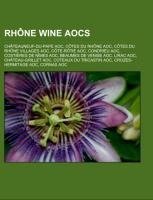
Rhône wine AOCs
Source: Wikipedia. Pages: 26. Chapters: Châteauneuf-du-Pape AOC, Côtes du Rhône AOC, Côtes du Rhône Villages AOC, Côte-Rôtie AOC, Condrieu AOC, Costières de Nîmes AOC, Beaumes de Venise AOC, Lirac AOC, Château-Grillet AOC, Coteaux du Tricastin AOC, Crozes-Hermitage... Viac o knihe
Produkt je dočasne nedostupný
12.67 €
bežná cena: 14.40 €
O knihe
Source: Wikipedia. Pages: 26. Chapters: Châteauneuf-du-Pape AOC, Côtes du Rhône AOC, Côtes du Rhône Villages AOC, Côte-Rôtie AOC, Condrieu AOC, Costières de Nîmes AOC, Beaumes de Venise AOC, Lirac AOC, Château-Grillet AOC, Coteaux du Tricastin AOC, Crozes-Hermitage AOC, Cornas AOC, Saint-Joseph AOC, Rasteau AOC, Gigondas AOC, Tavel AOC, Côtes du Ventoux AOC, Clairette de Die AOC, Côtes du Vivarais AOC, Côtes du Luberon AOC, Vacqueyras AOC, Saint-Péray AOC, Domaine du Vieux Lazaret, Vinsobres AOC. Excerpt: Châteauneuf-du-Pape is a French wine Appellation d'origine contrôlée (AOC) located around the village of Châteauneuf-du-Pape in the Rhône wine region in southeastern France. It is the most renowned appellation of the southern part of the Rhône Valley. Vineyards are located around Châteauneuf-du-Pape and in the neighboring villages Bédarrides, Courthézon and Sorgues between Avignon and Orange and covers slightly more than 3,200 hectares or 7,900 acres (32 km). Over 110,000 hectolitres of wine a year are produced here. More wine is made in this one area of southern Rhône than in the entirety of the northern Rhône region. The wine region of Châteauneuf-du-Pape is located within the Vaucluse department in southeastern France.Châteauneuf-du-Pape roughly translates to "The Pope's new castle" and, indeed, the history of this appellation is firmly entwined with papal history. In 1308, Pope Clement V, former Archbishop of Bordeaux, relocated the papacy to the town of Avignon. Clement V and subsequent "Avignon Popes" were said to be great lovers of Burgundy wines and did much to promote it during the seventy-year duration of the Avignon Papacy. At the time, wine-growing around the town of Avignon was anything but illustrious. While the Avignon Papacy did much to advance the reputation of Burgundy wines, they were also promoting viticulture of the surrounding area, more specifically the area 5-10 km north of Avignon close to the banks of the Rhône River. Prior to the Avignon Papacy, viticulture of that area had been initiated and maintained by the Bishops of Avignon, largely for local consumption. Clement V was succeeded by John XXII who, as well as Burgundy wine, regularly drank the wines from the vineyards to the north and did much to improve viticultural practices there. Under John XXII, the wines of this area came to be known as "Vin du Pape", this term later to become Châteauneuf-du-Pape. John XXII is also responsible for erecting the famous castle which stands as a symbo
- Vydavateľstvo: Books LLC, Reference Series
- Formát: Paperback
- Jazyk:
- ISBN: 9781155639901



 Anglický jazyk
Anglický jazyk 





 Nemecký jazyk
Nemecký jazyk 


